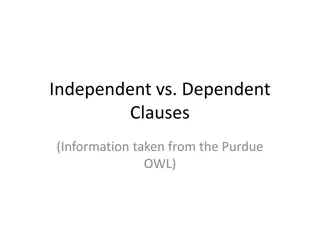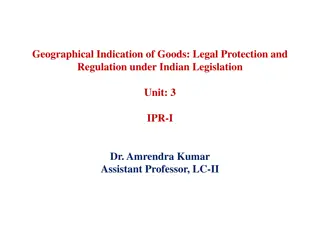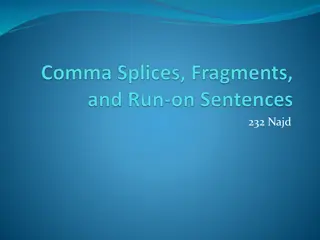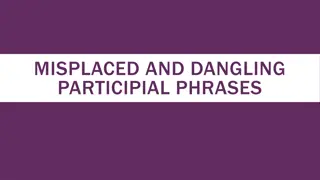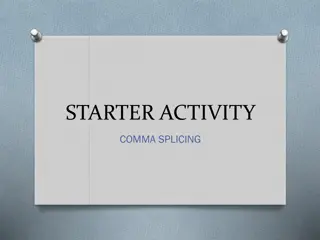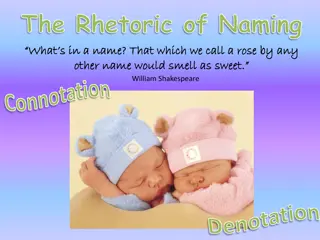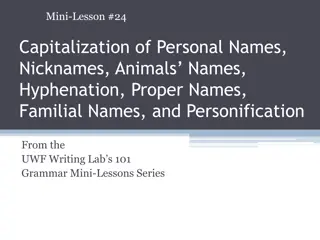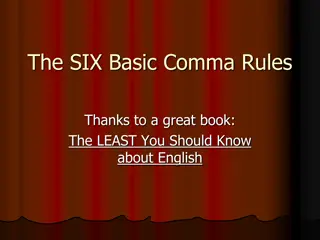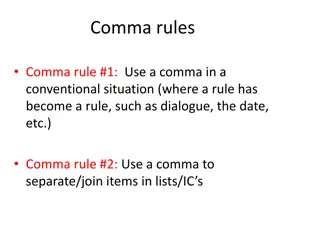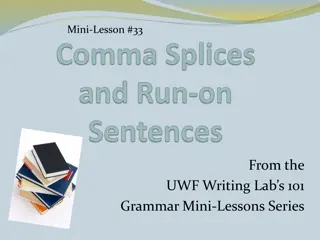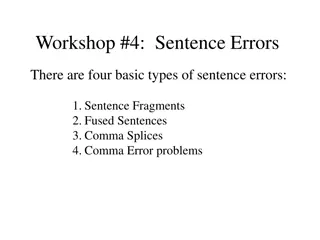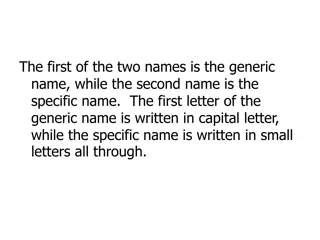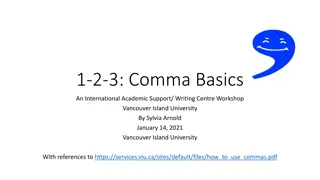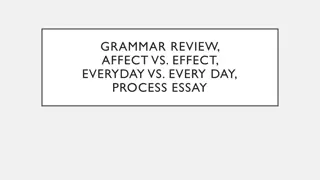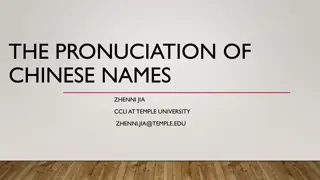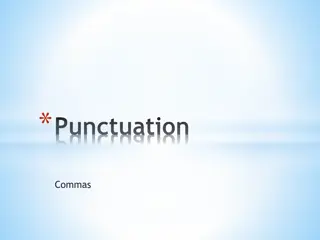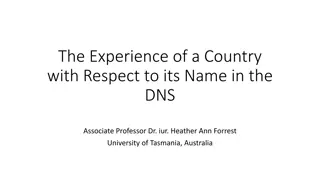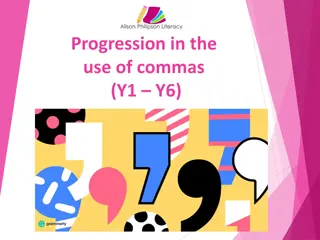Correct Comma Usage in Geographical Names
Proper comma placement in geographical names is essential for clear communication. This lesson covers when to use commas to separate parts of places such as cities, states, provinces, and countries. It also addresses using commas in series of words and numbers to enhance readability and accuracy in writing.
Download Presentation

Please find below an Image/Link to download the presentation.
The content on the website is provided AS IS for your information and personal use only. It may not be sold, licensed, or shared on other websites without obtaining consent from the author. Download presentation by click this link. If you encounter any issues during the download, it is possible that the publisher has removed the file from their server.
E N D
Presentation Transcript
Lesson 346 Mechanics - Punctuation - Commas Use commas to separate parts of geographical places. (city, state or town, province, country) Example: Have you visited St. Louis, Missouri? Instructions: Place commas where they are needed. 1. A neat place we visited was Custer Wyoming. 2. In Cody Wyoming there is an interesting museum. 3. I enjoyed the zoo in San Diego California. 4. We saw many bears in Waterton Alberta Canada. 5. The Black Hills are in South Dakota.
1. A neat place we visited was Custer Wyoming. A neat place we visited was Custer, Wyoming. 2. In Cody Wyoming there is an interesting museum. In Cody, Wyoming there is an interesting museum. 3. I enjoyed the zoo in San Diego California. I enjoyed the zoo in San Diego, California. 4. We saw many bears in Waterton Alberta Canada. We saw many bears in Waterton,Alberta, Canada. 5. The Black Hills are in South Dakota. The Black Hills are in South Dakota. (no comma needed)
Lesson 347 Mechanics - Punctuation - Commas Use commas to separate a series of three or more words. Example: I dropped my pencil, papers, and books. (The comma before the conjunction and is called an oxford comma, I will expect you to use it, but you may have teachers in the future who don't.) Use no commas between two or more words usually thought of as being one item. Example: We ate hamburgers, pork and beans, and potato chips. Use no commas in a series when all items are joined by or, and, or nor. Example: You dance and sing and play well. Instructions: Place commas where they are needed. 1. I have seen many gold silver and copper mines. 2. People in the United States can travel by air rail or water. 3. The girl waved leaned over and fell into the pool. 4. My wife likes a meal of a glass of grape juice a fresh salad and spaghetti and meatballs. 5. At the resort we can hike and swim and ski all we want.
1. I have seen many gold silver and copper mines. I have seen many gold, silver, and copper mines. 2. People in the United States can travel by air rail or water. People in the United States can travel by air, rail, or water. 3. The girl waved leaned over and fell into the pool. The girl waved, leaned over, and fell into the pool. 4. My wife likes a meal of a glass of grape juice a fresh salad and spaghetti and meatballs. My wife likes a meal of a glass of grape juice, a fresh salad, and spaghetti and meatballs. (Spaghetti and meatballs are considered one item.) 5. At the resort we can hike and swim and ski all we want. At the resort we can hike and swim and ski all we want. (no commma needed)
Lesson 348 Mechanics - Punctuation - Commas Use commas to separate a series of three or more numbers. Example: He called for numbers 3, 6, 9, and 12. Instructions: Place commas where they are needed. 1. In the Bingo game the winning numbers were 7 21 35 46 and 72. 2. My combination for my lock is 3 54 and 26. 3. He said that his lucky numbers were 7 11 13 and 99. 4. The numbers 14 27 58 79 and 38 won the lottery. 5. I like mixed greens with numbers of 20 50 and 100 on them.
1. In the Bingo game the winning numbers were 7 21 35 46 and 72. In the Bingo game the winning numbers were 7, 21, 35, 46, and 72. 2. My combination for my lock is 3 54 and 26. My combination for my lock is 3, 54, and 26. 3. He said that his lucky numbers were 7 11 13 and 99. He said that his lucky numbers were 7, 11, 13, and 99. 4. The numbers 14 27 58 79 and 38 won the lottery. The numbers 14, 27, 58, 79, and 38 won the lottery. 5. I like mixed greens with numbers of 20 50 and 100 on them. I like mixed greens with numbers of 20, 50, and 100 on them.
Lesson 349 Mechanics - Punctuation - Commas Use commas to separate a series of three or more phrases. Example: He ran down the hall, out the door, and into the yard. (The comma before the conjunction and is called an oxford comma, I will expect you to use it, but you may have teachers in the future who don't.) Use no commas in a series when all items are joined by or, and, or nor. Instructions: Place commas where they are needed. 1. The rain splashed against the house onto the sidewalk and into the street. 2. Through the trees around the cabin and down the valley roared the wind. 3. College is to gain knowledge to make new friends and to prepare for a career. 4. The cat climbed up the tree and out on a limb and finally onto the roof. 5. Munching on an apple listening to a recording and sitting on the couch Martha looked very happy.
1. The rain splashed against the house onto the sidewalk and into the street. The rain splashed against the house, onto the sidewalk, and into the street. 2. Through the trees around the cabin and down the valley roared the wind. Through the trees, around the cabin, and down the valley, roared the wind. 3. College is to gain knowledge to make new friends and to prepare for a career. College is to gain knowledge, to make new friends, and to prepare for a career. 4. The cat climbed up the tree and out on a limb and finally onto the roof. The cat climbed up the tree and out on a limb and finally onto the roof. -- no comma needed -- 5. Munching on an apple listening to a recording and sitting on the couch Martha looked very happy. Munching on an apple, listening to a recording, and sitting on the couch, Martha looked very happy.
Lesson 350 Mechanics - Punctuation - Commas Use commas to separate a series of three or more short clauses. Example: I am working, he is sleeping, and she is singing. (The comma before the conjunction and is called an oxford comma, I will expect you to use it, but you may have teachers in the future who don't.) Use no commas in a series when all items are joined by or, and, or nor. Instructions: Place commas where they are needed. 1. They are eating we are drinking and you are starving. 2. The music began the lights dimmed and the curtains opened. 3. My sister has left home my brother is at school and my mother is baking bread. 4. Jim fished Jeff hiked and I loafed the whole campout. 5. You correct he proofreads but I edit material.
1. They are eating we are drinking and you are starving. They are eating, we are drinking, and you are starving. 2. The music began the lights dimmed and the curtains opened. The music began, the lights dimmed, and the curtains opened. 3. My sister has left home my brother is at school and my mother is baking bread. My sister has left home, my brother is at school, and my mother is baking bread. 4. Jim fished Jeff hiked and I loafed the whole campout. Jim fished, Jeff hiked, and I loafed the whole campout. 5. You correct he proofreads but I edit material. You correct, he proofreads, but I edit material.


